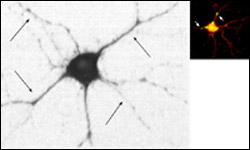
RNA Splicing in Nerve Cell Dendrites: Impact on Learning and Memory

Implications for study of memory, learning, and cognition
Researchers at the University of Pennsylvania School of Medicine have discovered that nerve-cell dendrites have the capacity to splice messenger RNA (pre-mRNA), a process once believed to only take place in the nucleus of cells. By uncovering this capability in dendrites, the investigators hope to relate this capacity to memory and learning, as well as cognitive dysfunction. Senior author James Eberwine, PhD, Professor of Pharmacology, and lead authors Kevin Miyashiro, and Jason Glanzer, PhD, both in Eberwine’s lab, report their findings in this week’s early online edition of the Proceedings of the National Academy of Sciences.
Dendrites, which branch from the cell body of the neuron, play a key role in the communication between cells of the nervous system, allowing for many neurons to connect with each other to form a network. Dendrites detect the electrical and chemical signals transmitted to the neuron by the axons of other neurons. The synapse is the neuronal structure where this chemical connection is formed, and investigators surmise that the synapse is where learning and memory occur.
Researchers have long agreed that mRNA splicing takes place within the cell nucleus. In the nucleus of a mammalian cell, a gene is copied into mRNA, which possesses both exons (mature mRNA regions destined to code for proteins) and introns (non-coding regions). mRNA splicing works by cutting out introns and merging together the remaining exon pieces, resulting in an mRNA capable of being translated into a specific protein.
The vast array of proteins within the human body arises in part from the many ways that mRNAs can be spliced and reconnected. Specifically, splicing removes pieces of intron and exon regions from the RNA, with the resulting spliced RNA often being made into protein. Should the RNA have different exons spliced in and out of it, then different proteins can be made from this RNA. The Eberwine lab was successful in showing that splicing can occur in dendrites because they have employed very sensitive technologies developed in their lab, which permits the detection and quantification of RNA splicing as well as the translated protein in single isolated dendrites.
“In addition to showing that mRNA splicing occurs in dendrites in which we added mRNA, we also detected the resulting protein,” notes Eberwine. “Since the splicing machinery is present in dendrites, one could speculate that if pre-mRNA is present naturally in the dendrite, when activated, it may be spliced and translated, giving rise to many different proteins.”
Protein diversity is a key aspect to the complexity of the central nervous system. Proteins are the workhorses of the cell and are generally responsible for insuring that cells function properly. When proteins interact with one another they can elicit specific physiological responses, including the generation and maintenance of memories. Changing protein identity, as can occur with splicing, can change the ability of the protein to interact with other proteins and therefore potentially change such physiological processes. With the dendrite being the initial site in the neuron where learning is thought to occur, the ability to create a diversity of mRNAs, through local splicing, and subsequent protein translation may permit exquisitely sensitive control of these cellular functions.
“The regulation and timing of the expression of proteins is what makes the central nervous system function,” says Eberwine. The diversity and redundancy of the nervous-system proteins may serve to help maintain the system over a lifetime. However, failure in protein regulation or proper expression in neurons may give rise to cognitive dysfunction. “Most neurodegenerative and psychiatric illnesses exhibit dendrite dysfunction, therefore, the inability to properly generate spliced RNAs in dendrites or proteins may underlie aspects of these disease processes.”
By revealing the capacity of mRNA splicing in dendrites, the investigators hope to develop an understanding of its role in cognition and dysfunction. Eberwine and colleagues are now working to find an endogenous mRNA that will undergo splicing within dendrites.
Co-authors in addition to Eberwine, Glanzer, and Miyashiro are Jai-Yoon Sul, Lindy Barrett, Brian Belt, and Phillip Haydon, all from Penn. This worked was funded by the National Institute on Aging and the National Institute on Mental Health.












